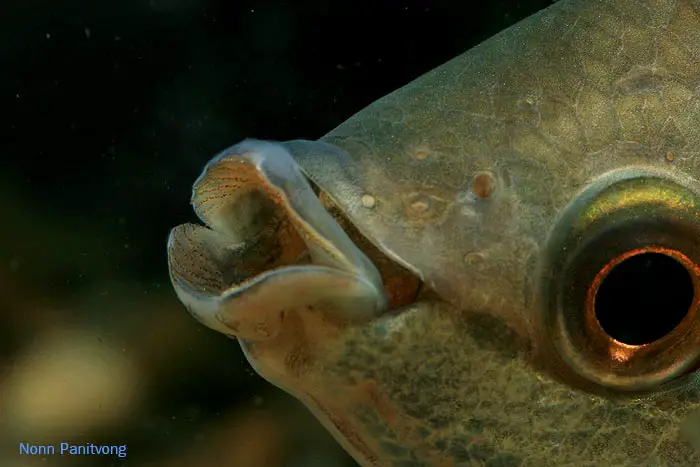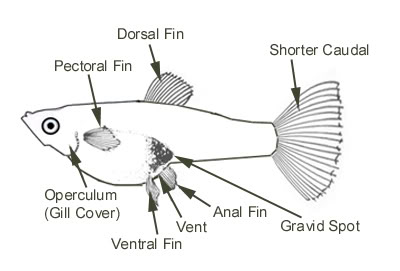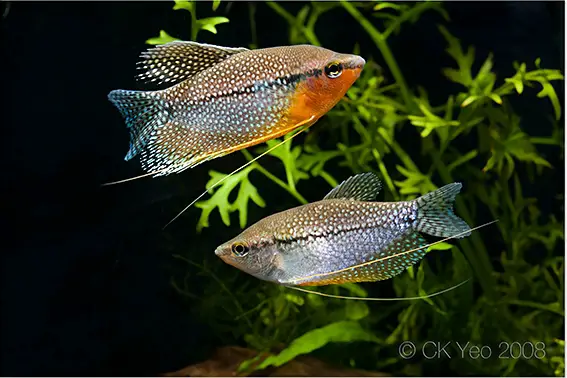The easiest way to keep multiple bettas!
Everyone knows that bettas need clean, warm water. Personally I don’t like to keep bettas in anything smaller than a 5 gal (19 L) because they are harder to maintain a cycle or proper temperature in. Most people have two to four bettas, and cleaning that many 5 gal (19 L) tanks can take a while. This is why the divided tank is my favorite way to keep bettas.The Basic Setup
The idea is to separate the bettas by a solid divider. Some people use plastic mesh, and some will use solid glass or plexiglass with tiny holes drilled for water movement. The intention is to physically separate the fish so they cannot touch each other. But the two fish can still see each other.
Left without any visual barriers, they will flare uncontrollably which is stressful to them. This can lead to fin-biting or wasting away. Some fish will refuse to eat and attempt to fight the other fish until they die. This is counter-productive. So you have to obscure their view of each other by placing numerous tall decorations along both sides of the divider. Some people use fake plants; some people use décor like castles and other trinkets. I prefer to use live plants. What is important is that these decorations make it easy for one betta to get out of sight of the other.
 |
| Newly set up divided 10 gallon tank (Pixiefarts @ Flickr) |
Most any size tank above 5 gallons (19 L) can be easily divided. The kinds of tanks you want to stay away from dividing are the tall tanks like hexigons. A tall and long tank like a 40 gal (150 L) breeder could be divided, but you would need to provide the bettas ample resting places close to the top. That is a tall tank for a fish with heavy fins. The most commonly divided tanks are 10 gal (38 L), 15 gal (56 L), 15 gal (56 L) long, 20 gal (75 L), and 20 gal (75 L) long.
Variations
There are a couple of variations on this idea, but they all have the basic concept. Some people add multiple dividers to a long tank such as a 20 gal (75 L) long. In a tank like this you could have between three and four (depending on preference) dividers. But you have to take special care to provide the betta in the middle with more than average hiding spaces because he will think he’s being attacked from both sides.
 |
| Divided 20 long (Jadesong520 @ photobucket) |
Some people take this a step further and create betta barracks. The methods to do this vary greatly from placing a lot of dividers in a tank to having glass custom cut and siliconed into place, but the outcome is the same. There are usually 4+ compartments in the front for bettas and a single large compartment behind the bettas to facilitate water flow, allow for a heater, and a filter. This method is preferred by breeders because it allows you to house hundreds of bettas in a pretty compact area using multiple barracks and industrial shelving racks.
 |
| Betta barracks for 10 bettas (LittleBettaFish @ Bettafish.com) |
My personal favorite dividing method is the double divider. Instead of just one divider in the tank, I use two to create three compartments, but only two compartments house fish. The middle one houses the heater and filter and a few plants. The additional divider makes it more difficult for the bettas to see each other and also offers a buffer zone in case of a jumper. Bettas are known to jump, and they do jump the divider from time to time. This HAS happened to me before while I was on vacation, but because of this middle buffer zone the bettas did not tear each other apart. They were there for hours until they were discovered. If not for this middle section, I could have come home to one or two dead bettas.
Problems
No setup is perfect and when you put two bettas in a tank together (even with a divider) you still have the potential for problems. As I was just talking about with my tank, jumping is a serious issue. Just last week a friend of mine who also has divided tanks lost one of her bettas when the other jumped the divider and beat him to death. The double divider is one way to help prevent that. The other thing you can do is make a jump guard. Because I made my dividers from craft mesh, which is bought in sets of multiple sheets, I had some left over. I cut the leftover mesh to make a jump guard. It’s just a piece of mesh that rests on top of the divider and hangs out over the edges about 3 inches (7 cm). If a betta jumps at the divider, he or she will just hit the mesh.
Another issue is the spread of waterborne diseases like ich, fungus, and columnaris. If one fish gets sick you have to treat the whole tank for it because the other betta (or bettas) have been exposed. Most disease can be prevented by having a good quarantine regimen.
Sometimes you will just get males or females that just can’t handle living in a divided tank. Even with lots of plants along the divider they will fin-bite or pace all day, trying to get away. Generally the bettas that are more relaxed tend to do better in divided tanks. Having two very aggressive bettas in a divided tank can be a problem. This is a specialized setup; it isn’t for every betta.
As I have said before this is my favorite way to keep bettas. You get double the fish for the same amount of maintenance. My betta tank gets one 30% water change weekly and takes the least time of all of my tanks. I highly recommend this type of setup to anyone. I leave you with a video of my divided betta tank. The two males do not notice each other at all.




























